Last Updated on January 12, 2024 by Greg Gillson
House Finches are common birds at our bird feeders throughout the United States. The males, with their red heads and brilliant songs are familiar to most backyard bird feeding enthusiasts.
House Finches are primarily resident throughout their range. So birds should stay all year to nest in your yard. You may wonder if you can provide a bird box for them to nest in. But you probably don’t have to!
House Finches, as their name implies, often build their nests on ledges and in crannies on outbuildings and porches. They will also build their nests in low dense conifers or bushes, and other surprising places.
This page is a supplement to my overview page on attracting House Finches.
The overview page leads to other in-depth pages on diet and foods to feed them at your feeder, their range and habitat preferences, and their identification. This page discusses courtship and nesting, eggs, nestlings, and fledglings. At the end of the article I’ll leave another link back to the overview page for you.
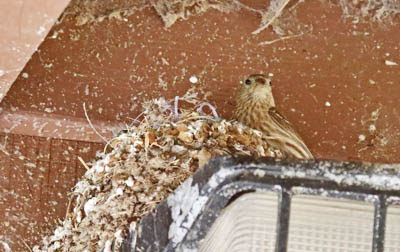 |
|
Female House Finch at nest
Photo by Greg Gillson
|
House Finch nesting habits and reproduction of House Finches
House Finches are monogamous, one male to one female. The nesting period of House Finches is quite protracted, March to August. This is because they lay more than one brood of eggs. As soon as the first nest has successfully raised young to fledging, the female starts a new nest. While laying 6 broods are possible, usually a pair of birds only has time to raise 3 broods successfully.
Courtship and mating of House Finches
Pair formation begins in spring, even within the larger winter flock. Males sing from an exposed perch, perhaps in the top of a small tree. Males also perform a “butterfly flight.” They fly up high and glide down slowly with fluttering flight, singing continuously.
Males sing all year. Females also sing in spring.
During courtship males may offer the female food. It’s a good sign for the male if the female begs and flutters her wings as a hungry baby bird would do!
Females seem to choose males that are brighter colored. The red color of the male is created by carotenoids in the diet. A brighter color could indicate a more physically fit bird, better able to find the best food, and thus giving a better chance at nesting success.
House Finches are not strongly territorial. Pairs may nest near each other. Though males are slightly larger, the females may be dominant over the males.
Some birds may remain paired all year.
House Finch Nest
The female builds a shallow cup-like nest. Nests are made of grasses, rootlets, plant stems, leaves, hair, cotton.
Nests may be placed in natural or artificial cavities, ledges, tree branches, bushes, cacti, corners of buildings, nest boxes, in conifers, palms, and ivy. They may even build their nest inside the old nests of other birds. They frequently nest in hanging flower baskets. The photo above shows a nest on a light fixture in a picnic shelter of a park.
The nests are usually 5-9 feet above the ground, but can be much higher or sometimes even on the ground.
Nests may be used more than once in a season or even in multiple seasons.
House Finch Nest Boxes
House Finches will use nest boxes. They need a larger entry hole size of 2 inches. At this size they may be out-competed by House Sparrows or Starlings, though.
The floor should be about 6×6 inches or 5×5 inches at the smallest. The floor to ceiling height can also be 6 inches. They entry hole should be 4-1/2 up from the floor.
Mount the box 5-10 feet high.
Most nest boxes you can buy are made with smaller entry holes for chickadees, wrens, and bluebirds. If I was to build a nest box for House Finches, it would not be totally enclosed. I would build the entrance as a half-wall maybe 3-4 inches high, with an opening at least 2 inches tall across the top.
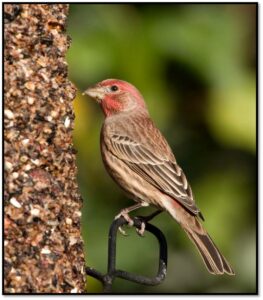
House Finch Eggs
As mentioned, House Finches can lay 6 batches or clutches of eggs in a single season. Usually, though, they only lay that many if the eggs or nestlings are taken by a predator before they fledge. There is only time enough during a breeding season to successfully lay about 3 broods.
The female lays 2-6 eggs (usually 4-5). House Finch eggs are about 0.6 to 0.8 inches long. They are bluish-white or pale greenish white in color. They have some black speckling on the larger end.
Eggs are usually laid in the morning, one egg per day. Incubation begins when the clutch is complete so they all hatch about the same time. The female does all the incubation of the eggs. They hatch in about 13-14 days. The female usually removes the eggshells from the nest after they hatch. During this incubation time the male may feed the female on the nest.
Because the breeding season is long, with multiple clutches, nests with eggs may be found February through August in the U.S.
House Finch Young–nestlings and fledglings
The young hatch naked and blind. Both parents feed the nestlings. House Finch babies are fed regurgitated dandelion seeds and similar small weed seeds. The parents keep the nest clean by carrying away or eating the fecal sacs of the baby birds. Yuck!
The young fledge from the nest when 12-19 days old. Once out of the nest the dad keeps feeding the fledglings for another 2 weeks. They learn how to fly and find their own food while chasing dad around and begging him to feed them!
Mom, on the other hand, abandons the family and lays another set of eggs. She either fixes up the old nest or builds a new one. When the male returns it is almost hatching time for the new brood and feeding the House Finch babies starts all over again!
Once independent, young birds start to form large flocks that they will stay in until spring.
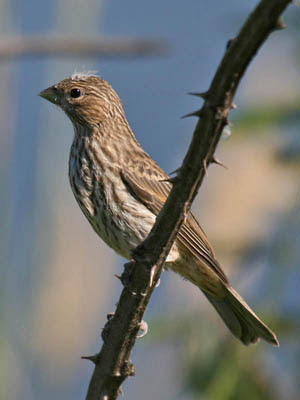 |
|
Juvenile House Finch
(see downy feather on head?)
Photo by Greg Gillson
|
Back to the overview page on attracting House Finches.
Wrapping Up
Here are some fascinating facts about the cheerful and ubiquitous house finch:
History and Distribution:
- Native to western North America, they were accidentally introduced to the eastern United States in the 1940s and have since spread across the continent and Hawaii.
- They are now the most common bird species in North America, often exceeding even the ubiquitous American robin in numbers.
Appearance and Song:
- Males boast a vibrant red head and breast, contrasting with their brown back and streaked underparts. Females are less colorful, with duller brown plumage and faint streaking.
- Their song is a lively, twittering melody, often described as “chee-chee-chee-cha-CHA”.
Diet and Feeding:
- House finches are primarily vegetarian, with seeds forming the bulk of their diet. They are particularly fond of sunflower seeds and will readily visit feeders.
- During breeding season, they may supplement their diet with insects for their protein needs, especially when feeding nestlings.
- Interestingly, they are among the very few bird species that have adapted to eat salt, often visiting roadsides or other sources to lick up salt deposits.
Behavior and Reproduction:
- House finches are social birds, often seen in small flocks, especially during winter.
- They are avid singers, with males using their song to attract mates and defend their territory.
- They build sturdy cup nests in trees, shrubs, or even vines, and can raise multiple broods in a single season.
- Interestingly, the red coloration of males is linked to their diet, with birds consuming more pigment-rich foods developing a brighter red plumage.
Unique Facts:
- Their scientific name, “Haemorhous mexicanus”, literally translates to “bloody Mexican rosefinch”.
- They are one of the few bird species that have been observed using tools, pecking at nutshells with rocks to gain access to the food inside.
- Their adaptability and resilience have made them a successful avian colonizer, thriving in a diverse range of habitats and urban environments.
Frequently Asked Questions
When do House Finches nest?
The nesting season for House Finches varies depending on their location and weather conditions, but generally falls within the following timeframe:
North America:
- Early March to early August: This is the broader nesting window for House Finches across North America. However, the specific start and end dates can vary significantly based on regional factors.
- Southern regions: Breeding tends to start earlier in warmer southern regions, with some pairs initiating nests as early as February.
- Northern regions: Nesting commences later in colder northern regions, often starting in late April or early May.
- Second broods: In warmer areas with longer breeding seasons, House Finches may raise two or even three broods in a single year.
Additional factors affecting nesting:
- Weather: Mild winters and early springs can trigger earlier nesting, while harsh weather conditions can delay the breeding season.
- Food availability: The abundance of seeds and insects, especially for feeding nestlings, also plays a role in determining the timing of nesting.
Do House Finches return to the same nest?
While House Finches don’t typically reuse the same nest, their nesting site fidelity is quite strong. This means they often return to the same general area to breed year after year, even if they build a new nest within that location. Here’s a breakdown of their nest-building habits:
Nest reuse:
- House Finches rarely reuse the exact same nest. Factors like wear and tear, parasites, or unsuccessful hatches can make them less desirable for subsequent broods.
- However, they may sometimes rebuild their nest in the same tree or shrub, often within a few feet of the previous year’s location.
Site fidelity:
- Female House Finches exhibit strong site fidelity, meaning they have a high preference for returning to the same breeding area year after year.
- This is likely due to familiarity with the food resources, shelter, and potential nesting locations in their chosen territory.
- Males may also show some site fidelity, although they are less consistent than females in returning to the same area.
Benefits of site fidelity:
- Returning to a familiar area allows House Finches to capitalize on their knowledge of the local resources and potential threats.
- This can provide advantages in finding food, avoiding predators, and raising their young successfully.
Overall:
- While House Finches don’t directly reuse their nests, their strong site fidelity often leads them to rebuild within the same familiar territory, promoting nesting success and contributing to their thriving populations.
Are house finch nests messy?
Yes, House Finch nests are generally considered messy. They are typically cup-shaped structures built with a variety of materials including:
- Grasses and twigs: These form the main structural elements, often woven together loosely.
- Leaves: Dead leaves and bits of foliage may be incorporated for insulation and camouflage.
- Bark and fibers: Shredded bark, plant fibers, and even string or hair can be found in some nests.
- Feathers: Feathers from the parent birds are often added to line the nest and provide warmth for the chicks.
The overall appearance of the nest can be described as untidy and cluttered, lacking the sleek and meticulous construction seen in some other bird species. However, despite their messy exterior, House Finch nests are functional and effective in protecting the eggs and chicks.
As they are so messy and they like to build their nests around houses, giving them a nest box is an even better idea!


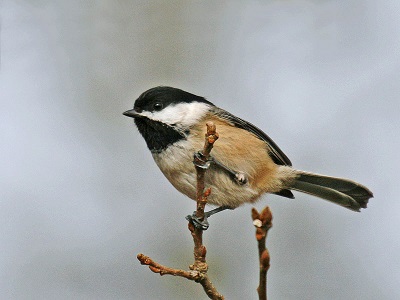
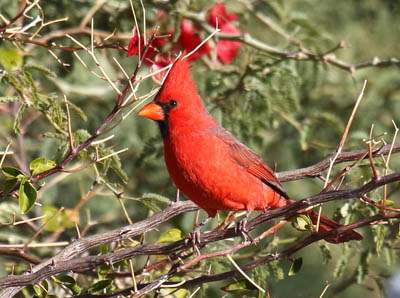
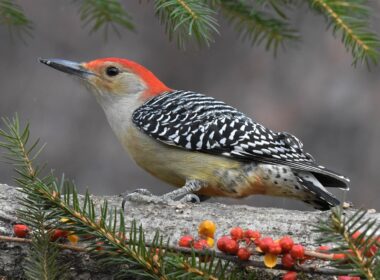
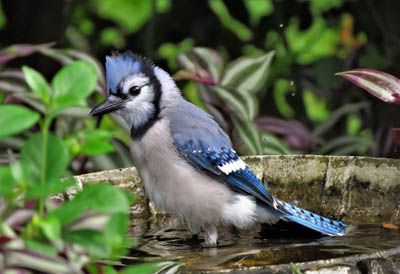
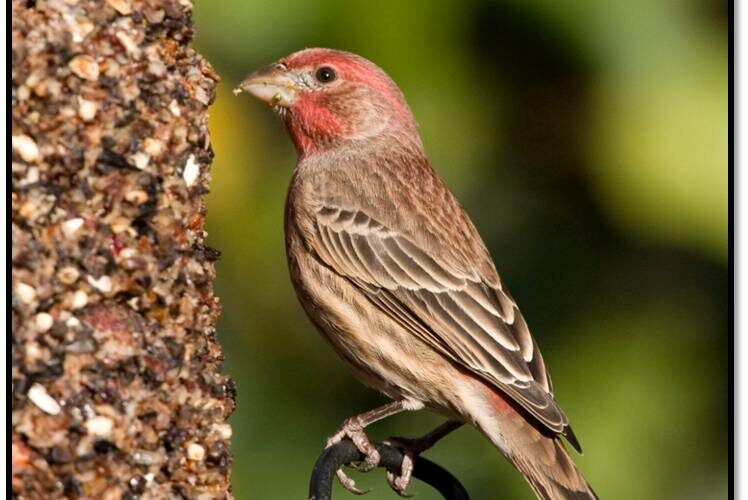
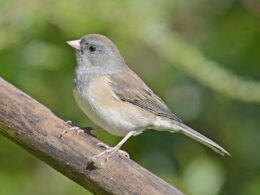
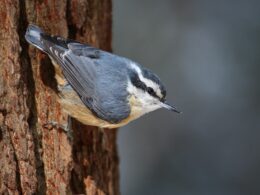
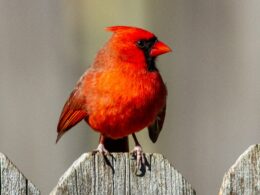

Great resource! I have many around my house. Just today I found a new nest in my screen house (they made it during the few days it rained!). Question: How many hours during the daylight hours do they need to sit on their nest? We eat at the table out there. I'd like not to have to avoid my screen house for another month. It's summer! Thank you 🙂
Great question!
Birds don't need to incubate all day and night.
Parent birds turn the eggs, provide heat at night, provide shade during the day.
In summer, if eggs are in shade, you should certainly be able to use your screen house for an hour or two for picnics a couple days a week.
I would avoid activities with many people and loud noises (like parties and loud music that goes until after dark).
I realize this is an older post, but we have noticed they tend to get used to us and often stay on the nest if we are nearby. They nest on our large front porch in wall baskets. We can't avoid using our front door so decided long ago that we'd be quiet and calm, but still present. They seem to realize eventually that we mean them no harm, and have also figured out we feed them.
House finches showed up this week looking for a nest sight. Based on what I've gleaned I put up two open nest boxes attached to the eve side of the facia board. Within minutes the pair showed up and began the selection process for their new home. They are fun to watch.
Do you have a guide for spacing additional boxes?
We have a nest with 6 eggs in our front door wreath. After several days we observed only one hatchling. Only the mother has been seen at the nest and no other eggs have hatched. This morning the 5-day old hatchling is dead but the mother is still at the nest. The remaining eggs are now weeks old. Is this mother possibly inexperienced or tending to other clutches elsewhere? She is gone a lot. We can see the nest from inside the glass door window. Appreciate any suggestions. There is an active barn swallow nest nearby.
House Finches are not territorial. So, you should be able to put up additional boxes nearby.
Could be an inexperienced mother, as you said. But sometimes wild animals do things we can't understand. But they seem to thrive anyway, despite the failures.
What a wonderful resource, thank you! A house finch built a nest in a planter outside my front window and laid several eggs about 18 days ago. It's been so lovely to watch. There are only two eggs now, and the mother continues to sit on them. It seems like this is longer than normal for the eggs to hatch. If the eggs aren't viable, will the mother continue to stay with them? Is it possible that she laid new eggs if the first set had been removed by a predator? I worry that the eggs will never hatch!
Partial or total nest failure in birds is common. I'm a few days late getting back to you. The eggs should have hatched by now. She'll abandon eggs eventually. (She can hear live chicks inside the eggs.)
Thank you so much for your information and help with finches! We have a nest underneath the awning on our deck. The eggs have hatched and once, as I sat quietly nearby, the mom came and I watched her head Bob up and down while she fed them! So cute!! It’s hard to see, as they’re well hidden, but now I can see the downy fuzz on the babies heads. Not sure how many are there. I can barely see two. I love watching them.
Thank you for your reply! The nest does appear to have been abandoned, so I'm hoping the finch has better luck with her next attempt. I appreciate your expertise!
How fun!
I just found a nest of 4 eggs in a Japanese Maple tree on my patio. Adorable. However I have a very interested cat that kills everything. What should I do? Can the nest be moved?
I've had a nest in my hanging fern, for the past 3 years. This year is very different. Sometimes there are as many as six finches, male and female, fluttering around the plant. She is sitting on the four eggs while this is happening. Have you seen this behavior before?
I have a nest in my hanging basket, being very careful to water every few days (so the plants stay alive and offer protection) – once they fledge, can I remove the nest and make it difficult for a new one so that they move on? or will that be harmful?
Not much you can do. The cat will likely find them no matter where you put the nest. Birds will probably abandon nest if moved with eggs.
These may be the young from earlier THIS year. This is likely a second nesting for the season.
Yes, after they fledge you may make changes. Hurry, though! They may nest again this season.
thank you for the reply…I'm devastated to say that something got them (was a crow hanging around)…I don't think they had hatched yet, there were no egg shells just an empty nest. I removed it and put some plastic balls in there so no room for a new one. I don't want to experience that heartache again, I was so excited, looking forward to some little baby birds.
This is the second year that finches have built a nest in my hanging ferns, but no eggs have been laid. It is not a particularly busy or loud area. Why is this happening?
Aww… that's too bad. So disappointing after getting you all excited.
Sometimes birds build practice nests, or more than one and eventually settle on the best. Sometimes something happens to one of the pair (death). These are my best guesses.
Love this page. I have 4 House Finches in a hanging geranium. They are about 16 days old. Way too big to fit in the nest anymore. I was watering the plant sparingly, but it is deteriorating quickly. Will the watering hinder them from taking off. Also, they have mites which when I do water hop right on me! I am getting impatient for them to leave, so I can save my plant!
Well, I'm a bit late in responding. Sorry. By now, whatever you did is done. Did you save the plant? Did the young fledge? Mites? Yuck! That's normal, I suppose.
I have a nest with four babies on my front porch. I wasn’t aware of the nest at first, and accidentally knocked the babies out of the nest when watering. I placed the babies back in the nest, but have yet to see mom or dad back to care for them! Now, I’m so consumed with worry that they won’t survive due to my negligence in not seeing the nest. What should I do?! They do have feathers, but I have no idea how old they are. Please help!
The parents will likely not abandon a nest with fledglings, even if disturbed.
I have lots of activity at my birdhouse the past few mornings with the parents going in and out of my house. I even have a few pieces of grass/twigs in there brought to start a nest. But it is November!! What are they doing? They aren't having babies at this time of the year are they? I know I am in California but it is still cold at night! What could they be doing?
House Finches maintain pair bonds all year. My guess is that he's showing how well he can provide so she doesn't decide the grass is greener with some other bloke!
I have some finches that build on my front porch every year. They started out building in a light fixture. The last couple years they built in my Easter Cactus. This year they built in a porch rocker. I enjoy watching them.
Wonderful, Teresa!
Hi! I live have a balcony on the third floor and house finches have built a nest in one of my hanging baskets. They are at least 30' from the ground and only partially hovering over my patio- only about a 5' fall. Is this too high? She has 4 eggs as of right now…
They're likely fine. Birds are light enough for their body size that they aren't injured falling. Chicks leave the nest before they can fly. The parents care for them in bushes on the ground.
Thanks for this article, very helpful. We have a nest in a wreath on our front door, which we open / close multiple times daily. Is there a way to move the nest to a safer place so that the birds have a chance and the humans here aren’t scared to open the door & get a bird in the house, knock the nest, or scare the parents away from tending to the eggs?
That's quite the dilemma! I suspect moving the nest will cause them to abandon it. But, if you can't avoid using the door for a couple of weeks, then you might try it. The earlier you do this the better.